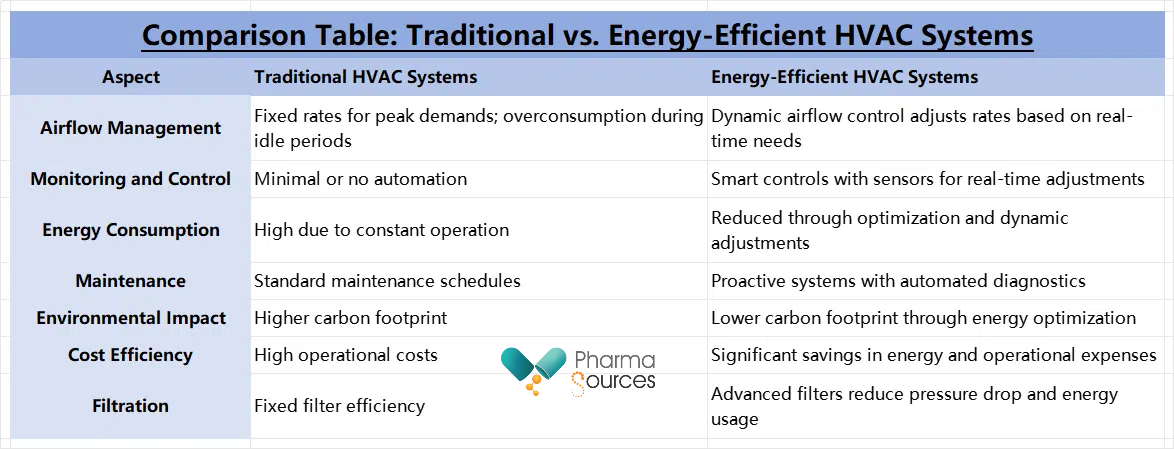Saher HaiderDecember 12, 2024
Tag: HVAC Systems , Cleanrooms , Reducing Costs
Abbreviated for Heating, Ventilation, and Air Conditioning, HVAC Systems are indispensable to pharmaceutical manufacturing facilities. They maintain a specific temperature range, control humidity and air quality, regulate airflow, and maintain pressure control. However, HVAC systems in pharmaceutical cleanrooms have clear requirements regarding airflow, pressurization, and recirculation – all of which skyrocket their operational costs.
According to a global cleanroom technology market research report, the cleanroom tech market size is valued at USD 56.9 Bn in 2023 and is expected to reach USD 185.7 Bn by 2031.
This growing demand for cleanroom technology is due to strict contamination control requirements across the pharmaceutical and other life sciences industries.
But here comes the most important part:
While HVAC systems are critical to support unhindered cleanroom operations, they come with heavy operational costs. The only way to combat this is to introduce energy efficiency as a sustainable solution to manage costs while still ensuring compliance with key international standards such as ISO 14644 Cleanrooms and Separative Devices and BS EN ISO 14644-14:2016, which set strict guidelines for cleanliness, airflow, and energy use.
In this article, we will discuss the main features of energy-efficient HVAC systems and how you can reduce their energy consumption without compromising compliance or performance.
So, without further ado, let’s dive right into the article!
HVAC systems are responsible for up to 50-60% of the total energy used in cleanroom facilities, making up most of the cleanroom operation costs. Before diving into methods to reduce operational costs in cleanrooms, let’s first review factors that drive high cleanroom HVAC energy consumption.
Cleanrooms require high air change rates (ACH) to maintain particle-free environments. In some classifications, air may be exchanged 60-600 times per hour, meaning they consume more fan and motor energy to sustain these high velocities and volumes.
In cleanrooms, air must pass through high-efficiency particulate air (HEPA) or ultra-low penetration air (ULPA) filters to remove contaminants. To work efficiently, HEPA and ULPA filters create significant pressure drops that ultimately require more energy to move air through the system.
Temperature and relative humidity are among a few things that are monitored first thing in the morning in pharmaceutical manufacturing industries and then maintained throughout all operational and storage areas to ensure product quality and stability. However, maintaining these parameters in environments with extreme external conditions or during seasonal fluctuations adds substantial energy demand – especially in energy-intensive cleanroom systems.
Cleanrooms rely on high airflow and robust circulation systems to mitigate viable and non-viable particles introduced by personnel, equipment, and processes at all times, contributing to high energy usage.
Energy-efficient HVAC systems are specifically optimized to reduce energy consumption without compromising air quality, temperature and humidity control, and pressure levels. Following are some strategies that can be used to cut operational costs and improve the efficiency of cleanroom HVAC systems:
Regular Maintenance: Regular maintenance of HVAC systems is often undermined yet remains one of the most effective ways of improving efficiency. The air handling units, boilers, and chillers should be kept clean, and their sensors should be calibrated regularly.
Reduce Over-operation and Use Night Setback Modes: Over-operation and manual overrides increase energy consumption. Thus, HVAC equipment should only be operated when needed.
Use Efficient Filtration Technologies: Incorporating pre-filters alongside advanced HEPA and ULPA filters can significantly reduce the load on HVAC systems. Pre-filters capture larger particles, allowing high-efficiency filters to work optimally with less energy demand, resulting in a reduction in overall system strain and energy use.
Use Energy-Saving Components: Features such as LED lighting integration and heat recovery systems enhance energy savings. Heat recovery systems, for instance, repurpose waste heat generated during operation to reduce the load on heating components, cutting energy consumption.
Smart Monitoring and Controls: Advanced sensors and building management systems (BMS) optimize energy use by enabling real-time monitoring of air quality, temperature, and humidity, allowing the system to adjust dynamically to the cleanroom's specific needs without overworking the equipment. Smart controls also minimize energy waste by preventing overcooling or overheating.
Retrofit Older Systems: Retrofitting older HVAC systems with modern energy-efficient components, such as variable frequency drives or efficient filters, is a cost-effective way to improve performance without the high capital expense of a full replacement.
Optimize Air Change Rates: Tailoring air exchange rates to the specific cleanroom classification can yield energy savings while maintaining compliance with ISO and GMP requirements.
Traditional HVAC systems operate on fixed airflow and are designed to meet peak cleanroom demands even when such conditions are unnecessary, leading to significant energy consumption. These systems also lack dynamic control features, meaning air exchange rates, temperature, and humidity levels remain constant regardless of operational needs. For example, these systems maintain the same airflow during non-operational hours, resulting in overconsumption.
In contrast, Energy-Efficient HVAC systems use advanced technologies such as dynamic airflow controls and real-time monitoring to optimize energy use. These systems also adjust parameters like air exchange rates, temperature, and humidity based on operational requirements. For instance, a 30% reduction in air exchange rates can lead to approximately 66% energy savings, as fan energy consumption is proportional to the cube of the airflow rate. Energy-efficient systems achieve this reduction by integrating features like inline particle counters, energy recovery systems, and smart controls.

Adopting energy-efficient HVAC solutions for cleanrooms can significantly reduce energy costs while maintaining strict compliance with industry standards. Innovations such as dynamic airflow controls, integrated monitoring systems, and advanced filtration technologies are some of the strategies pharmaceutical organizations can use to reduce the environmental and operational costs of cleanroom facilities.
If you’re a cleanroom operator seeking to optimize your facilities, now is the perfect time to explore state-of-the-art HVAC systems. Visit PharmaSources resources to connect with industry professionals and discover cutting-edge HVAC technologies to improve cleanroom efficiency.
Saher Binte Haider is a pharmacy graduate from Dow University of Health Sciences. She started her career as a Quality Management professional in the pharmaceutical industry where she developed a keen interest in good documentation practices, SOP creation, and content writing. She has 7+ years of experience in healthcare & life sciences content writing. Her key areas of expertise are healthcare, pharmaceuticals, health tech, and AI in healthcare.


Contact Us
Tel: (+86) 400 610 1188
WhatsApp/Telegram/Wechat: +86 13621645194
+86 15021993094
Follow Us:




 Pharma Sources Insight July 2025
Pharma Sources Insight July 2025


